March 28, 2002
Lacrosse: A cross between everything
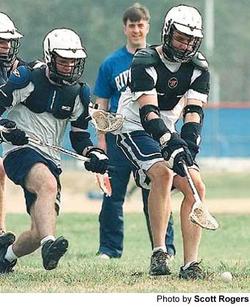 Lacrosse is North America's oldest sport. You would think, then, that most people would have heard of it by now.
Lacrosse is North America's oldest sport. You would think, then, that most people would have heard of it by now.
That's not the case in Northeast Georgia. Even though lacrosse was played religiously here by the Cherokee, Creek and Oconee Indian tribes hundreds of years ago (the town of Ball Ground, in fact, was named for the sport), most local folks don't know the difference between lacrosse and Lamaze.
But Riverside Military Academy hopes to change all of that. The private boarding school added lacrosse to its lineup of varsity sports this spring, becoming the first area school to do so. In fact, the closest school on the Eagles' schedule is some 40 miles away.
Forty cadets -- approximately 10 percent of RMA's student body -- tried out for the first lacrosse team in school history. Most of them had never picked up a lacrosse stick before.
"I had heard about it, but I had never seen it or anything," Bart Mayers, a junior from Jacksonville, Fla., said. "I just thought it was some stupid guys just throwing a ball. I had no idea. Until you play, you really don't know how cool a sport it is."
Mayers admitted he's still learning lacrosse, even though the Eagles' season is now coming to an end. Still, he, like each of his teammates, is considered a resident expert at Riverside.
"A lot of the cadets are fascinated because they've never seen a sport like this," Mayers said. "It's really new to everybody. Everybody asks a lot of questions."
Answering the questions isn't always easy. I learned that when I was quizzing Riverside coach Joel Coleman prior to my participation in a practice last week.
Lacrosse can be hard to describe. When talking to me, Coleman likened lacrosse to football, baseball, soccer, hockey and basketball.
Finally, he said, "It's really a combination of every game that I can think of. It's not really a cross, it's an amalgamation of a whole bunch of different things. It's just a really fun sport. If you could pick out whatever you liked about any sport, that's what lacrosse is."
Lacrosse is played on a field close in size to the ones used for soccer. The strategy is similar to that of any sport played with one ball and two goals: Try to score more than your opponent.
What makes lacrosse unique is that the fundamentals, the basics of the game, are the most difficult skills to master. Learning how to pass and catch can take weeks, months even. Some people, even very gifted athletes, never get the hang of it.
Imagine playing hockey without knowing how to skate, or soccer without knowing how to kick.
"To kids who have never seen it before," said Coleman, who grew up playing lacrosse in Maryland, "it's like trying to teach them how to walk on Mars. We started practice on the 28th of January and most of them couldn't even throw and catch. Now they look like they know what they're doing -- for the most part."
Stick-work is the key to lacrosse. You pass, catch and scoop the ball using a long stick, called a crosse, that has a net pocket on one end. Only the goalies are allowed to use their hands.
It's hard to get the depths down. Consider trying to catch a baseball with your glove stuck on the end of a broomstick.
"You'll probably do better than I did my first day," sophomore Falcon Layton, of Colorado said to me as we walked to the practice field. "I got hit by the ball."
That can be painful. The lacrosse ball is a tad smaller than a baseball and made of solid rubber.
It's not just the ball lacrosse players must worry about, either. Lacrosse is a very physical sport, with body checks and stick checks.
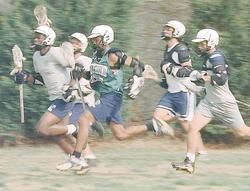 In fact, the word American Indians in the Southeast used to describe lacrosse translates into "little brother of war."
In fact, the word American Indians in the Southeast used to describe lacrosse translates into "little brother of war."
Therefore, helmets, mouthpieces and shoulder pads are mandatory. Arm pads, rib pads and protective cups are highly recommended.
Coleman helped me don my body armor before the practice. I felt like an extra in that futuristic Backstreet Boys video from a few years back. I think it was for the song "Larger Than Life." (Note: If you were born prior to 1980, just imagine a "Star Wars" stormtrooper.)
Coleman told me that the day's practice was going to be an easy one. The team was scheduled to have its fifth match of the season the following day.
I'd hate to see Coleman's idea of a hard practice. I was wasted after "warm-ups."
Running with a helmet on is like carrying a sauna around on your shoulders. I'd say it got heavy, if it didn't make me so lightheaded.
One running drill in particular put me over the edge. It's called the "Indian run." The team jogs single file. The person at the end of the line must sprint to the front. And so on, and so on.
I thought we were just going around our practice field ... until we started going around the adjacent field, too. That's fine, I thought ... until we started running around the baseball field after that.
I figured we must have been headed to a far-off water fountain, or maybe a swimming pool. We weren't.
"I think we got (a water break) yesterday," said junior Don Taylor, of Hilton Head, S.C., "and I think that was the first time all season we had one. And that was because people were about to throw up."
I figured journalists are out of Coleman's jurisdiction. So I ducked out during the next part of practice and drank from a nearby hose.
All the running is not without reason, however. That's what players do in a game.
"It came as a surprise," said Malachi Dodge, a sophomore from Athens. "It was a lot faster paced than I thought it would be. In a game, it's nonstop unless the ball goes out of bounds."
The Eagles are 2-3 heading into spring break. Not too shabby for beginners.
They defeated South Cobb, another first-year team, 16-0. Sprayberry forfeited to Riverside last week.
"It's surprising," said Taylor, one of the few Riverside players with previous lacrosse experience. "Our team picked it up quick and we've been able to hang with a lot of the teams. We go into games thinking we're a first-year team. But after a while, we realize that we're as good as they are as long as we put the effort in."
At the Academy, like any rookie squad, the lacrosse team is paying its dues. When I asked one of the cadets why we were practicing on a spotty field that had patches of gravel, he told me it was because they didn't want to tear up their game field.
Meanwhile, the long-standing Riverside soccer team was practicing over on the lacrosse field, tearing it up.
"We're earning our respect," Taylor said, noting that attendance at their matches has increased dramatically since the start of the season. "Gradually, people are starting to pick it up. They're like, 'Oh, that looks fun. I'm going to play next year.'"
March 21, 2002
Horseback Riding: Honey back in saddle after rough ride
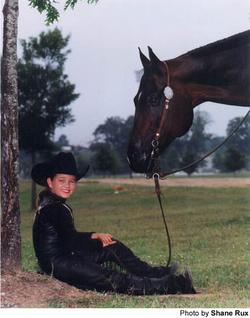 For 15 seconds or so, Dodie Ellison thought that her granddaughter was dead. Nine-year-old Honey Beth Campbell lay motionless in the dirt. A horse named Hunker had just put her through hell.
For 15 seconds or so, Dodie Ellison thought that her granddaughter was dead. Nine-year-old Honey Beth Campbell lay motionless in the dirt. A horse named Hunker had just put her through hell.
When I heard the story, it made my stomach sink. In the fall of 2000, Honey gave me a lesson in competitive Western horseback riding for a Sporting Life column. She introduced me to her horses: Hunker, the younger one she won a state championship on, and Godfather II, the aged one whose sagging back she learned to ride upon.
Readers fell in love with Honey. So did I. And I'm relieved to report that this story has a happy ending.
No one is really sure what spooked Hunker, the 13-year-old show horse Honey had ridden without incident for three years, back on Dec. 23. As Dodie said, "Who knows what horses see?"
For whatever reason, Hunker bolted. And Honey was helpless. The 81-pound fourth-grader dangled upside-down, her foot stuck in its stirrup, as the 1,400-pound horse that she loved so much raced frantically around the round pen at Three S Farms in East Hall. With each step that he took, Hunker whacked Honey in the head with his hind leg.
All Dodie could do was watch.
"I heard this little voice say, 'Help me, Toad,'" Dodie remembered. "And I will hear those words 'til the day I die."
Dodie and Honey are about as close as a grandmother and granddaughter can be. They have nicknames for each other: Dodie is Toad, Honey is Worm.
Eventually, Worm worked her foot free, and Hunker sent her flying. Honey landed in a heap, and Dodie -- sprinting to her granddaughter's side -- feared the worst.
But Honey coughed, and Dodie raised her head. Blood poured from Honey's mouth.
That didn't stop her from talking, however. She told Dodie that she couldn't breathe. She said her arm hurt.
Then Honey turned to her grandmother and asked, "Is Hunker OK?"
Dodie raced Honey to the emergency room. A CT scan came up negative. The diagnosis was a serious concussion, a deep tissue twist in her arm and a cut-up mouth.
But in the days that followed, Honey didn't show signs of improvement. If anything, she was getting worse.
She stayed in the hospital for nine days. The first four were the worst. She vomited constantly and stared at the wall like a vegetable. The only thing she said was, "Don't touch me."
"When I was in the hospital," Honey said, "I thought, 'I hope I'm not going to be like this forever.'"
Honey's parents were worried, and they called in a specialist. It's a good thing they did. The specialist discovered that Honey had a cranial bleed, bleeding on the layer of the skull that attaches to the brain.
It's an injury that can be serious. But in Honey's case, thankfully, it looks like it was caught in time.
"The doctors told us in no uncertain terms that she was one whack away from being very seriously injured," Honey's mother Jordan Campbell said. "It scares me today when I think about it. It makes me sick, really.
"I have no doubt that God was looking out for her. That's the only way I know how to explain it. I don't know what else it could be."
Honey lost 12 pounds in the hospital. She missed Christmas. She wasn't able to ride the new dirt bike her parents had bought for her. She wasn't able to ride her horses. She wasn't able to do much of anything.
"I had to miss the first snow," lamented Honey, now 10 and a student at Mount Vernon Elementary. "My brother got to play outside and I was really jealous."
Hunker, meanwhile, refused to eat for several days after the accident. He knew that he had done something wrong.
"I wasn't mad at him," Honey said. "My mom was, though."
Jordan, admittedly not much of a horse person to begin with, added, "I hate to say this, but if she never got on again it would suit me. But I would not do that to her."
When Honey returned to school, she had trouble staying awake. She'd lay her head on her desk and sleep for hours.
The recovery process from such an injury involves a lot of waiting. And the waiting isn't over yet. Honey still suffers from the occasional headache. She's got knots on the side of her head. Her arm is still hard to the touch.
"I think most of it will go away in like a few years," Honey said. "But I'm riding now."
Yep, doctors cleared Honey to hop back on a horse three weeks ago -- as long as she agrees to wear a helmet. She took her first ride March 5 ... on Hunker.
"I was looking forward to it," Honey said. "But when I first got on, I took a deep breath and went, 'Here it goes.' And I just started riding like I always did."
Well, almost. She hadn't worn a helmet before. She'll never ride without one again.
"Anybody should wear a helmet, I think," Honey said. "Because it could happen to anybody."
NOTE: If you were wondering, good ol' Godfather II turned 28 on March 1. Honey and Dodie sang "Happy Birthday" and gave him a full box of thin mint Girl Scout cookies.
"And we put the pearls on old Godfather," Dodie said. "He always has to wear the birthday pearls."
March 14, 2002
Geocaching: Not just for geeks anymore
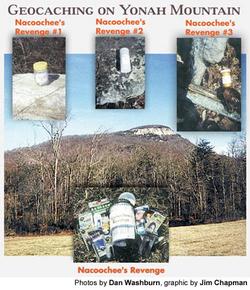 Hi. My name is Dan. And I'm a geocacher. There, I said it. Are your geek alarms going off?
Hi. My name is Dan. And I'm a geocacher. There, I said it. Are your geek alarms going off?
Believe it or not, I've never watched a full episode of "Star Trek." I still haven't seen the most recent "Star Wars" installment. And I have no interest in reading "The Lord of the Rings" -- I saw the movie, and left the theater rather unimpressed.
But after my first geocaching experience last March -- also the subject of a Sporting Life column -- I went right out and plunked down $100 for my first Global Positioning System unit. A GPS is an electronic device that, based on latitude and longitude coordinates, pinpoints your exact location on Earth and allows you to seek out any other specific location.
I have hiked to 12 caches -- think hidden treasure ... of very little value -- since finding that first one atop Ramrock Mountain on the Appalachian Trail near Suches one year ago.
And some of those caches have involved as much as 14 miles of hiking. Who are you calling a geek now?
Geocaching has led me to beautiful, odd and out-of-the-way spots throughout Georgia and beyond, places I likely never would have stumbled upon otherwise. Geocaching is like an online referral service for hikers: "Here, I really liked this area. Now you try to find it."
Most caches are of the traditional variety, a Tupperware container or ammo box filled with an assortment of trinkets and a log book. There are also micro-caches, which can be as small as a film canister, and multi-caches, which can involve several stages.
Then there are what the more outdoors-oriented geocachers refer to as "drive-by caches." These require very little effort to get to, and are primarily placed by those interested more in electronics than exercise. The real geeks, if you will.
"There are the geeky types that just do it in the city," said Allen Lacy, 47, of Toccoa, who has found 113 caches and placed seven since September 2000. "But the ones I run across seem to be like me: a little of both. They are gadget freaks that like the outdoors."
Geocaching has only existed since May 2000 -- that's when the U.S. government stopped intentionally degrading the GPS signals available to the public -- but it has grown considerably since. When I last wrote about geocaching, there were just 33 caches hidden in Georgia. Now there are 268, and 13,870 active caches in 109 countries throughout the world.
"When I started, I had to drive all over the state just to find a geocache," said 50-year-old Erik van Dyck, of Suwanee, perhaps the most active geocacher in Georgia, with a staggering 274 caches found since last February. "But now there are plenty of them."
But as the number of geocachers out there increases, so does the number of obstacles that geocachers face. National parks have decided not to allow caches. State parks in Georgia don't, either.
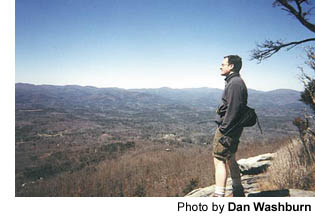 Persuading the Georgia Department of Natural Resources to rethink its geocaching ban is one of the primary reasons the Georgia Geocaching Association was formed. As Lacy said, GGA members want the DNR to know "that we're not a bunch of idiots running out and digging holes."
Persuading the Georgia Department of Natural Resources to rethink its geocaching ban is one of the primary reasons the Georgia Geocaching Association was formed. As Lacy said, GGA members want the DNR to know "that we're not a bunch of idiots running out and digging holes."
The GGA has nearly 100 members and meets monthly, usually in metro Atlanta. It is one of the first statewide geocaching organizations in the country.
But geocaching remains primarily an online community. Visitors to www.geocaching.com use handles like CacheNinja and GeorgiaGeoDude. They log their cache visits on the web site and sometimes discuss the hobby in chat rooms.
"You'll find people that seem to spend more time on the forums discussing geocaching than they do actually doing it," van Dyck said. "I guess I'm just the opposite. I enjoy looking for them. I enjoy even more putting them out. That's really fun."
Van Dyck started geocaching as a way to lose weight and get outdoors. Soon, the "hobby became an obsession." Van Dyck is often the first person to find newly placed caches in Georgia.
"I go during business trips," van Dyck said. "Rather than go to the happy hour buffet late in the afternoon, I go to geocaching.com and find out what caches might be in the area and get in my little rental car and go for it."
 I know one Georgia cache that van Dyck hasn't found yet. It's called Nacoochee's Revenge and it's the first cache on Yonah Mountain. I know this, because I put it there on Sunday -- the day I graduated further into geocaching geekdom.
I know one Georgia cache that van Dyck hasn't found yet. It's called Nacoochee's Revenge and it's the first cache on Yonah Mountain. I know this, because I put it there on Sunday -- the day I graduated further into geocaching geekdom.
I challenge you to seek Nacoochee's Revenge. Of course, van Dyck will likely beat you to it. "I can quit anytime I want," van Dyck said with a chuckle. "I know I can."
Geo What?
• Geocaching (pronounced geo-cashing) is a worldwide game for users of the Global Positioning System, or GPS. The game basically involves a GPS user hiding "treasure" -- the cache and its contents -- and publishing the exact coordinates on the Internet so other GPS users can go on a "treasure hunt" to find it. The rules? They are simple. If you take something from the cache, you must leave something in the cache.
• About GPS: The GPS is a satellite-based navigation network that allows users of GPS receivers to pinpoint their location on the planet (within around 20 feet) using latitude and longitude coordinates. The GPS consists of 24 2,000-pound satellites, situated more than 12,000 miles in space, that constantly orbit the Earth.
• In Georgia: At presstime, there were 268 caches hidden in Georgia and 36 within a 25-mile radius of Gainesville. The Georgia Geocachers Association has nearly 100 members and meets monthly. Visit the GGA online at: www.ggaonline.org.
• On the Web: www.geocaching.com
March 7, 2002
Hiking: Waterfalls are welcome during tournament time
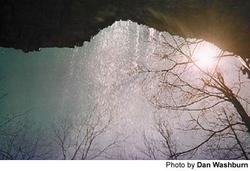 Sometimes you need to get away.
Sometimes you need to get away.
I spent the better part of last week covering the first three rounds of the state basketball tournament in Rome.
I am now on a first-name basis with the staffs of the Days Inn and Applebee's there. I know well the roads that link the gymnasiums at Floyd College, Shorter College and The Forum.
I covered 11 games in five days in Rome. But that was just the beginning.
As I write this column, I am seated on press row, midcourt at the Macon Coliseum for the state final four -- and the girls from Paideia are currently piled up before me celebrating their last-second win.
This is hoops heaven I've been living in these past several days. But even for the most diehard of basketball fanatics, such a schedule can be taxing. The body craves some fresh air and an atmosphere that doesn't include parents screaming at referees.
So last Friday, before my slate of games tipped off, I left the Days Inn and headed 40 miles north to Walker County -- a place in dire need of some positive publicity, thanks to a creepy crematorium that makes HBO's "Six Feet Under" play like "Happy Days."
My destination was the Keown Falls Scenic Area in the Chattahoochee National Forest, although I didn't know it at the time.
My original goal was to hike the 6.3-mile Chickamauga Creek Trail. But I slept in too late for that thanks to some latenight helpings of the television vacuum known as "elimiDATE." It just sucks you in, doesn't it?
My second, and shorter, choice was the 3.1-mile Johns Mountain Trail, located in the same general vicinity. But the access road to that trail was blocked off by the U.S. Forest Service.
 I was left with the Keown Falls Loop Trail, found just another mile down Pocket Road. It turned out to be not such a bad alternative, after all.
I was left with the Keown Falls Loop Trail, found just another mile down Pocket Road. It turned out to be not such a bad alternative, after all.
The Keown Falls Scenic Area, named after land surveyor Gordon Keown, is a 218-acre plot in the Ridge and Valley section of Georgia's topography. It is the only scenic area in the western portion -- or Armuchee Ranger District -- of the Chattahoochee National Forest, which lies separate from the part of the forest most Northeast Georgians enjoy.
The centerpiece of the scenic area, not surprisingly, is Keown Falls, which is rather finicky as far as falls go. It only flows after wet weather. Luckily, I was met by a sign that read "WATERFALL IS FLOWING" at the trailhead.
The loop trail is short (1.7 miles) and rather easy, but perfect for hikers who have little time and little desire to show up for their first basketball game of the afternoon stinking of sweat.
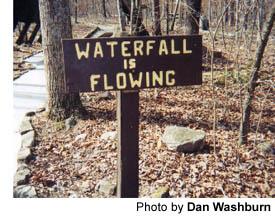 The trail begins at the Keown Falls Recreation Area and, through a series of gradual switchbacks, climbs Johns Mountain roughly 500 feet in elevation to an observation deck overlooking the falls.
The trail begins at the Keown Falls Recreation Area and, through a series of gradual switchbacks, climbs Johns Mountain roughly 500 feet in elevation to an observation deck overlooking the falls.
Johns Mountain Trail shares the observation deck and can be found just a few yards away.
The deck offers a nice view of the falls, which cascade over a moss-covered -- and on this day, ice-covered -- ledge and soak the red rock 60 feet below. Look to the left and you see Furnace Valley. Beyond that, Horn Mountain.
But the best view of the falls, I suggest, is from underneath. That's right, the trail actually travels beneath and behind the wall of water. If the wind is right, the mist sprays your face as you make the approach.
I imagine, on a warmer day, it would be nice to stand on the rock and let the waterfall fall right on your head.
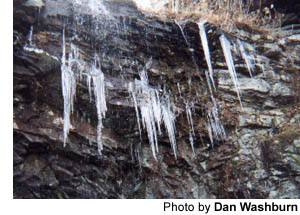 But temperatures barely left the 30s last Friday, and some of the long, sharp icicles that hung from the outcrop like temporary stalactites looked like they could cause a great deal of pain.
But temperatures barely left the 30s last Friday, and some of the long, sharp icicles that hung from the outcrop like temporary stalactites looked like they could cause a great deal of pain.
Instead, I sat for a while just a few feet away and listened. The only sound I could hear was water hitting rock.
The trail continues with a tall ridge of rock on the right until it comes upon a smaller waterfall, which during my visit was frozen instead of flowing.
The path then passes through a thick forest of tall trees -- during winter, brown and leafless -- and travels past tiny tributaries that eventually flow into Johns Creek.
Last week, the only color was provided by the blue sky, a few ferns and the moss that covered fallen trees.
I arrived back at my car refreshed, ready to return to the gym and confident that once the ragging of the refs returned, I could turn to the sound of Keown Falls, which was still flowing through my head.